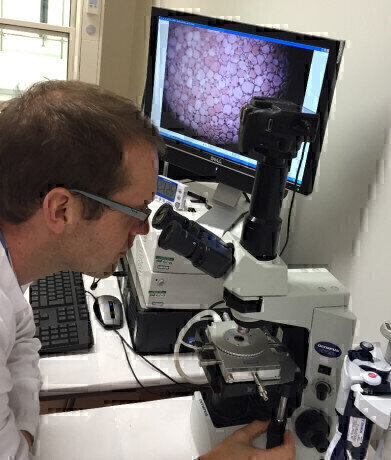Microscopy & Microtechniques
Cryo Stage Helps in the Development of New Cryoprotectants for Biological Storage
Dec 18 2015
Dr Matthew Gibson is an Associate Professor at the University of Warwick where he leads a diverse research team. His research is focused at the interfaces of Organic and Polymer Chemistries with the Life Sciences.
One particular area of research is the design and synthesis of antifreeze (glyco)protein (AFP) mimics. AFPs are found in a range of species which can survive in extreme cold temperatures by preventing, or slowing the rate of ice growth. This growth of ice is also a major problem in the cryopreservation of donor cells and tissue for transplantation. The best technologies currently available involve adding large amounts of organic solvent to the cells which is obviously not ideal for future transplantation. If the group can improve the storage of cells it could really improve the scope for regenerative medicine procedures. Dr Gibson and his colleagues are seeking to make synthetic polymers, which mimic the function of AFPs, and have had some success at this recently.
Dr Gibson's group uses the Linkam BCS196 cryobiology stage to assist with research into antifreeze proteins, with the aim of producing novel cryoprotectants for biological storage. He describes why he chose the Linkam stage and the results it has helped to produce:
“To measure antifreeze function, we needed to use a stable, temperature controlled cryo-stage for our microscopes, to enable us to measure ice crystal growth. The Linkam BCS196 cryobiology stage gives us good temperature control and the ability to carefully increase or decrease the temperature as needed. In our recent studies we have focussed on identified new ‘motifs’ (structural features) which have AFP-like function, even though they do not ‘look like’ AFPs. Whilst there are very good methods for doing this, they are rather slow and we wanted to see if we can start to use more high-throughput or rapid methods to screen for activity quickly. In this paper we use gold nanoparticle aggregation as a marker for AFP-like activity and we were happy to see that for our polymers, it was quite predictive. We will be testing it with a wider range of compounds in the future as a route to identify new AFP mimetic materials which can then be studied in more detail for both activity and cryopreservation.”
Digital Edition
Lab Asia 31.2 April 2024
April 2024
In This Edition Chromatography Articles - Approaches to troubleshooting an SPE method for the analysis of oligonucleotides (pt i) - High-precision liquid flow processes demand full fluidic c...
View all digital editions
Events
Apr 22 2024 Marrakech, Morroco
Making Pharmaceuticals Exhibition & Conference
Apr 23 2024 Coventry, UK
Apr 23 2024 Kintex, South Korea
Apr 23 2024 Seoul, South Korea
Apr 24 2024 Jakarta, Indonesia








.jpg)









